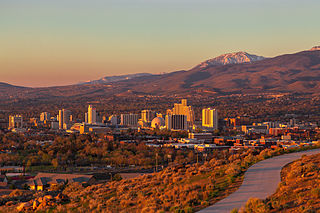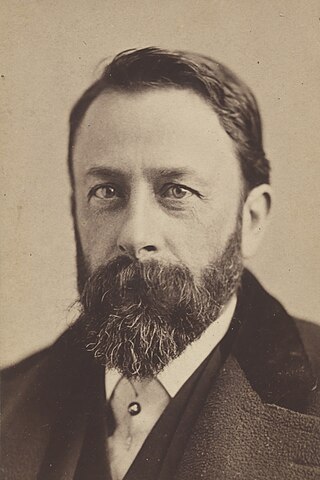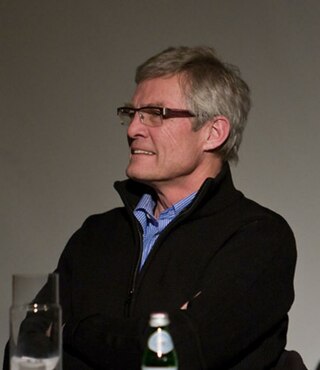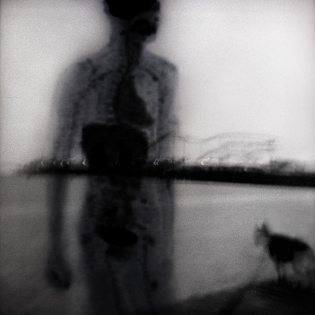Related Research Articles

Reno is a city in the northwest section of the U.S. state of Nevada, along the Nevada–California border, about 22 miles (35 km) north from Lake Tahoe, known as "The Biggest Little City in the World". It is the county seat and most populous city of Washoe County sitting in the High Eastern Sierra foothills, in the Truckee River valley, on the eastern side of the Sierra Nevada. The Reno metro area occupies a valley colloquially known as the Truckee Meadows, it is the 81st most populous city in the United States, the 3rd most populous city in Nevada, and the most populous in Nevada outside the Las Vegas Valley.

Ansel Easton Adams was an American landscape photographer and environmentalist known for his black-and-white images of the American West. He helped found Group f/64, an association of photographers advocating "pure" photography which favored sharp focus and the use of the full tonal range of a photograph. He and Fred Archer developed a system of image-making called the Zone System, a method of achieving a desired final print through a technical understanding of how the tonal range of an image is the result of choices made in exposure, negative development, and printing.

Albert Bierstadt was a German American painter best known for his lavish, sweeping landscapes of the American West. He joined several journeys of the Westward Expansion to paint the scenes. He was not the first artist to record the sites, but he was the foremost painter of them for the remainder of the 19th century.
Robert Adams is an American photographer who has focused on the changing landscape of the American West. His work first came to prominence in the mid-1970s through his book The New West (1974) and his participation in the exhibition New Topographics: Photographs of a Man-Altered Landscape in 1975. He has received two Guggenheim Fellowships, a MacArthur Fellowship, the Deutsche Börse Photography Prize and the Hasselblad Award.
Frank Gohlke is an American landscape photographer. He has been awarded two Guggenheim fellowships, two fellowships from the National Endowment for the Arts, and a Fulbright Scholar Grant. His work is included in numerous permanent collections, including those of Museum of Modern Art, New York; the Metropolitan Museum of Art; and the Art Institute of Chicago.

Rodney Lough Jr. is an American landscape photographer and gallery owner.

Maynard Dixon was an American artist. He was known for his paintings, and his body of work focused on the American West. Dixon is considered one of the finest artists having dedicated most of their art to the U.S. Southwestern cultures and landscapes at the end of the 19th-century and the first half of the 20th-century. He was often called "The Last Cowboy in San Francisco."

John O'Brian is an art historian, writer, and curator. He is best known for his books on modern art, including Clement Greenberg: The Collected Essays and Criticism, one of TheNew York Times "Notable Books of the Year" in 1986, and for his exhibitions on nuclear photography such as Camera Atomica, organized for the Art Gallery of Ontario in 2015. Camera Atomica was the first comprehensive exhibition on postwar nuclear photography. From 1987 to 2017 he taught at the University of British Columbia, Vancouver, where he held the Brenda & David McLean Chair in Canadian Studies (2008-11) and was an associate of the Peter Wall Institute for Advanced Studies. O'Brian has been a critic of neoconservative policies since the start of the Culture Wars in the 1980s. He is a recipient of the Thakore Award in Human Rights and Peace Studies from Simon Fraser University.
Just Loomis is a fine art photographer known for his portraiture and fashion photography. His work has been published and exhibited internationally and has appeared in Harper's Bazaar, British Vogue, Vanity Fair, The New Yorker, and The New York Times Magazine. His book of American portraits, "As We Are" was published in 2010 by Hatje Cantz.
Deborah Springstead Ford is an American photographer noted for her fine art black and white combination printed photographs exploring ambiguous perceptual realities. She has photographed her family, western landscapes and cultural artifacts, with much of her photographic work drawing on the relationships between science and art, the natural world and cultural geography. Most recently her photographs of oil and gas exploration in the Powder River Basin and the high desert west have received attention and been published in Arid. Her work has been exhibited in solo and group exhibits in museums and galleries around the continent, and is included in many private and public collections such as the Center for Creative Photography, California Museum of Photography, and Northlight Gallery. She has been an arts advocate, educator and program administrator in addition to being a professional visual artist for over 30 years. Ford attended Minneapolis College of Art & Design, Arizona State University and Goddard College. She has a BFA in Photography, a Master's in Art Education/Photographic Studies and an MFA in Interdisciplinary Arts. She was a professor of Photographic Studies at Prescott College. She taught photography full-time from 1982 to 2013, the last 18 years at Prescott College in northern Arizona. As an arts advocate, Ford was instrumental in the creation of the Prescott College Art Gallery. The gallery and Ford have both been nominated for Arizona Governor's Art Awards. She has received numerous awards and fellowships, including four Arizona Commission on the Arts Grants and participated in many Artist-in-Residence programs around the country including the Biosphere 2, Ucross Foundation, Anderson Center for Interdisciplinary Arts, Sitka Center for Art & Ecology, Joshua Tree National Park, Isle Royale National Park, and Aspen Guard Station. Ford's photographs have been exhibited nationally and internationally. Recent publications include a profile in Black and White Magazine, Issue #82. and photographs in Orion magazine. Ford was the executive director of Playa, in Summer Lake Oregon, a residency program for visual artists, scientists, writers and others engaged with creative inquiry from 2013 to 2017.

Joanna Frueh (1948–2020) was an American artist, writer, and feminist scholar.
Betty Hahn is an American photographer known for working in alternative and early photographic processes. She completed both her BFA (1963) and MFA (1966) at Indiana University Bloomington. Initially, Hahn worked in other two-dimensional art mediums before focusing on photography in graduate school. She is well-recognized due to her experimentation with experimental photographic methods which incorporate different forms of media. By transcending traditional concepts of photography, Hahn challenges the viewer not only to assess the content of the image, but also to contemplate the photographic object itself.
Holly Roberts is an American visual artist known best for her combination of photography and paint. “Holly Roberts caused a stir in the fine art photography world of the eighties by fusing painting and photography, painting directly onto photographs”. Roberts lives and works in Corrales, New Mexico. Her work is in the permanent collection of several museums in the United States.
Cara Romero is an American photographer known for her digital photography that examines Indigenous life through a contemporary lens. She lives in both Santa Fe, New Mexico and the Mojave Desert. She is an enrolled citizen of the Chemehuevi Indian Tribe.
Mark Ruwedel is an American landscape photographer and educator.
Peter Kayafas is an American photographer, publisher, and educator based in New York City. He creates black and white photographs that are "simple and spare, yet quietly overpowering with their evocation of a history on a scale beyond that of individual human lives."

Jamey Stillings is an American photographer and artist known primarily for his aerial photography of renewable energy projects around the world, documenting the human impact on the environment. Stillings presents at photo festivals, universities, and professional conferences globally. His work is exhibited and published widely in Asia, Australia, Europe, and North and South America. His award-winning book, The Evolution of Ivanpah Solar, documents the Ivanpah Solar Electric Generating System in the Mojave Desert of California. His photographs are in private and public collections, including the United States Library of Congress, Museum of Fine Arts - Houston, Los Angeles County Museum of Art, and Nevada Museum of Art.

Dooby Lane is a folk art installation located near Gerlach, Nevada in the Black Rock Desert. Dooby Lane consists of a series of art installations that include aphorisms and the names of local residents carved in to stones. Larger installations such as "Ground Zero", Elvis, Imagination Station – Desert Broadcasting System are also present.

Michael Light is a San Francisco-based photographer and book maker whose work focuses on landscape, the environment, and American culture's relationship to both. He is known for aerial photographs of American western landscapes collectively titled "Some Dry Space: An Inhabited West" and for two archival projects focused on historical photographs of the Apollo lunar missions and U.S. atmospheric nuclear detonation tests, represented by the books Full Moon (1999) and 100 Suns (2003), respectively. Los Angeles Times critic Leah Ollman characterized his work as "largely about what we consider ours, how we act on that assumption, and what the visual manifestations of those claims look like ... [It] seduces and troubles in shifting measure."

Linda Alterwitz is an American visual artist whose work Integrates art, science and technology, investigating the inner workings of the human body and its connection to the natural world and cosmos. Her practice includes photographic and collaged works, immersive installations and participatory methods, and employs alternative imaging devices ranging from low-tech plastic cameras to advanced medical diagnostic machines. Her complex images frequently superimpose medical visualizations onto abstracted portraits and landscapes, blurring distinctions between the outer body, its underlying systems and organs, and the external environment.
References
- ↑ "Peter Goin". Archived from the original on 2009-12-01. Retrieved 2009-09-16. University of Nevada Reno Art Faculty Page
- ↑ http://www.petergoin.com/?q=node/65 Goin, Peter. Nuclear Landscapes. 1st ed. George F. Thompson. Baltimore: Johns Hopkins University Press, 1991.
- ↑ http://www.petergoin.com/?q=node/99 Artists Website
- ↑ Goin, Peter. Humanature. University of Texas Press, 1996
- ↑ Goin, Peter and Paul F. Starrs. Black Rock. 1st ed. Reno: University of Nevada Press, 2005
- ↑ http://www.aptonline.org/catalog.nsf/GenreLookup/666233DEC676510685256C45004F7276 American Public Television
- ↑ "Black Rock (Paperback) | Black Rock Institute".
- ↑ Field Guide to California Agriculture by Paul Starrs, Peter Goin - Paperback - University of California Press.
- ↑ "Home". visitnationalparkarts.org.